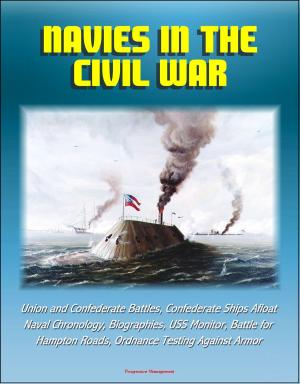The Impact of Training and Equipment at the Battle of Attu, Aleutian Campaign: Historical Study and Current Perspective - Unprepared and Ill-equipped World War II Cold Weather Debacle, Arctic Lessons
Nonfiction, History, Military, Strategy, World War II| Author: | Progressive Management | ISBN: | 9781370481552 |
| Publisher: | Progressive Management | Publication: | April 4, 2017 |
| Imprint: | Smashwords Edition | Language: | English |
| Author: | Progressive Management |
| ISBN: | 9781370481552 |
| Publisher: | Progressive Management |
| Publication: | April 4, 2017 |
| Imprint: | Smashwords Edition |
| Language: | English |
This excellent report has been professionally converted for accurate flowing-text e-book format reproduction. In the Aleutian Campaign of 1942-1943, the United States of America fought the only land battle against an invading nation on American territory during the past 100 years at the Battle of Attu. The 7th Infantry Division based out of Fort Ord, California was tasked by the War Department for the main offensive element. Initial battle plans called for a three-day operation to retake the island; unfortunately for the soldiers, the battle lasted twenty-two days. During the prolonged battle, the cold injury and wounded-in-action rates were nearly identical. This study explores the impact of inadequate training and ineffective equipment on the 7th ID soldiers whose previous focus on North Africa shifted to the North Pacific with less than three months for preparation. This study will also discuss current relevance of the lessons learned regarding the United States Arctic Strategy.
The Central Pacific Theater of World War II often overshadows the North Pacific Theater, contributing to its nickname of "forgotten" or "silent" war. During the Aleutian Campaign of 1942-1943 at the Battle of Attu, the United States of America fought the only land battle on American territory against an invading nation in the past 100 years. Japanese troops seized control of Attu Island on the morning of June 7, 1942. Nearly a year later, on May 11, 1943 the 7th Infantry Division, based out of Fort Ord, California began an assault to reclaim the remote island. The purpose of this study is to examine how training and cold-weather equipment impacted tactical operations for the 7th Infantry Division at the Battle of Attu. The staggering fact is that in twenty-two days of combat, the 7th Infantry Division sustained 3,829 casualties of which 1,200 (31 percent) were due to the cold.
After the battle, leaders and planners who looked back on the operations concluded that the soldiers were unprepared and ill-equipped for operations in the Aleutians. Upon reflection of the soldiers from the Battle of Attu, a naval officer stated, "Willing to fight but . . . poorly prepared, badly equipped, and just pitiful." The men who survived the battle described the harsh, severe weather conditions; their clothing and equipment proved unsatisfactory to this extreme environment. The clothing provided little warmth, was not windproof or waterproof, and the leather boots were totally inadequate; all contributed to soldiers' susceptibility to cold-weather exposure and trench foot during the Battle of Attu.
This excellent report has been professionally converted for accurate flowing-text e-book format reproduction. In the Aleutian Campaign of 1942-1943, the United States of America fought the only land battle against an invading nation on American territory during the past 100 years at the Battle of Attu. The 7th Infantry Division based out of Fort Ord, California was tasked by the War Department for the main offensive element. Initial battle plans called for a three-day operation to retake the island; unfortunately for the soldiers, the battle lasted twenty-two days. During the prolonged battle, the cold injury and wounded-in-action rates were nearly identical. This study explores the impact of inadequate training and ineffective equipment on the 7th ID soldiers whose previous focus on North Africa shifted to the North Pacific with less than three months for preparation. This study will also discuss current relevance of the lessons learned regarding the United States Arctic Strategy.
The Central Pacific Theater of World War II often overshadows the North Pacific Theater, contributing to its nickname of "forgotten" or "silent" war. During the Aleutian Campaign of 1942-1943 at the Battle of Attu, the United States of America fought the only land battle on American territory against an invading nation in the past 100 years. Japanese troops seized control of Attu Island on the morning of June 7, 1942. Nearly a year later, on May 11, 1943 the 7th Infantry Division, based out of Fort Ord, California began an assault to reclaim the remote island. The purpose of this study is to examine how training and cold-weather equipment impacted tactical operations for the 7th Infantry Division at the Battle of Attu. The staggering fact is that in twenty-two days of combat, the 7th Infantry Division sustained 3,829 casualties of which 1,200 (31 percent) were due to the cold.
After the battle, leaders and planners who looked back on the operations concluded that the soldiers were unprepared and ill-equipped for operations in the Aleutians. Upon reflection of the soldiers from the Battle of Attu, a naval officer stated, "Willing to fight but . . . poorly prepared, badly equipped, and just pitiful." The men who survived the battle described the harsh, severe weather conditions; their clothing and equipment proved unsatisfactory to this extreme environment. The clothing provided little warmth, was not windproof or waterproof, and the leather boots were totally inadequate; all contributed to soldiers' susceptibility to cold-weather exposure and trench foot during the Battle of Attu.















